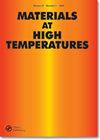奥氏体钢在超临界二氧化碳中的内部渗碳和结垢
IF 0.9
4区 材料科学
Q4 MATERIALS SCIENCE, MULTIDISCIPLINARY
引用次数: 0
摘要
直接燃烧的超临界二氧化碳(sCO2)动力循环正在商业化,以彻底改变化石能源作为低排放的动力来源。为了降低这项技术的成本,在循环的较低温度部分需要更便宜的钢材。然而,人们担心在sCO2中钢的内部渗碳。一个一致的观察是,与9-12% Cr铁素体-马氏体钢上形成的厚的富铁氧化物相比,薄的富Cr氧化物似乎减少了C的进入。先进的奥氏体不锈钢(SS),如709合金(20Cr-25Ni)能够在650°C下继续形成富cr氧化物,而传统的316 H SS形成富铁垢。在550°C - 650°C温度下,采用辉光放电光谱法和电子探针显微分析方法对SS样品中的C扩散谱进行定量分析。采用透射电镜分析方法,比较了709合金在650℃下在sCO2中形成的薄层富cr保护氧化物与在环境空气中形成的富cr保护氧化物。本文章由计算机程序翻译,如有差异,请以英文原文为准。
Internal carburization and scale formation on austenitic steels in supercritical carbon dioxide
ABSTRACT Direct-fired supercritical CO2 (sCO2) power cycles are being commercialised to revolutionise fossil energy as a low-emission power source. To lower the cost of this technology, less expensive steels are needed in the lower temperature segments of the cycle. However, there are concerns about internal carburisation of steels in sCO2. 1 A consistent observation is that thin, Cr-rich oxides appear to reduce C ingress compared to thick Fe-rich oxides formed on 9–12% Cr ferritic-martensitic steels. Advanced austenitic stainless steels (SS) like alloy 709 (20Cr-25Ni) are able to continue to form Cr-rich oxides at 650°C, while a conventional type 316 H SS formed a Fe-rich scale. The C diffusion profiles in SS specimens were quantified at 550°C–650°C using glow discharge optical emission spectroscopy and electron probe microanalysis. Analytical transmission electron microscopy was used to compare the thin protective Cr-rich oxide formed on alloy 709 in sCO2 at 650°C to that formed in ambient air.
求助全文
通过发布文献求助,成功后即可免费获取论文全文。
去求助
来源期刊

Materials at High Temperatures
工程技术-材料科学:综合
CiteScore
1.90
自引率
15.40%
发文量
58
审稿时长
>12 weeks
期刊介绍:
Materials at High Temperatures welcomes contributions relating to high temperature applications in the energy generation, aerospace, chemical and process industries. The effects of high temperatures and extreme environments on the corrosion and oxidation, fatigue, creep, strength and wear of metallic alloys, ceramics, intermetallics, and refractory and composite materials relative to these industries are covered.
Papers on the modelling of behaviour and life prediction are also welcome, provided these are validated by experimental data and explicitly linked to actual or potential applications. Contributions addressing the needs of designers and engineers (e.g. standards and codes of practice) relative to the areas of interest of this journal also fall within the scope. The term ''high temperatures'' refers to the subsequent temperatures of application and not, for example, to those of processing itself.
Materials at High Temperatures publishes regular thematic issues on topics of current interest. Proposals for issues are welcomed; please contact one of the Editors with details.
 求助内容:
求助内容: 应助结果提醒方式:
应助结果提醒方式:


